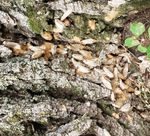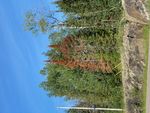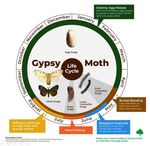Renfrew County Forest Health Update 2020 - Township of ...
←
→
Page content transcription
If your browser does not render page correctly, please read the page content below
Renfrew County Forest Health Update 2020
Prepared by L. Rose, R.P.F., County Forester
2020 has proven to be a challenge for both the residents and
trees of Renfrew County. Several notable forest pests made a
mark on the landscape this spring and summer. As is
becoming the norm in recent years, invasive species are
having the biggest impact on our forests.
Gypsy Moth
Gypsy moth (GM) is a non-native, invasive pest first detected
in Ontario in 1969, but widespread defoliation did not occur
until 1981. Since then it has caused major defoliation events
every 7 to 10 years in various parts of Ontario. Gypsy moth
has over 300 known host plants, but prefers oak, maple, birch,
white pine and white spruce. The impacts during a severe
defoliation year can be quite startling – a single gypsy moth
caterpillar can eat one square metre of leaves in a season.
There were areas of severe defoliation observed by the public
and County staff in Renfrew County during the spring and
early summer of 2020 – Calabogie and area, north and south
of Golden Lake, Dacre, Mount Saint Patrick, Springtown, and
Burnstown.
Although the immediate impacts of gypsy moth are
undesirable – trees stripped of leaves, caterpillars, moths and Figure 1. Gypsy moth laying egg masses on an oak in Barnet Park,
larvae everywhere – healthy trees can sustain 2-3 years of Calabogie. Photo by CoR.
heavy defoliation and often reflush in the same year. There
will be some mortality of already weakened trees, and the
increased stress does leave trees more susceptible to other
issues, for example, drought. Outbreaks have historically
collapsed after a few years when naturally occurring viruses or
fungus that target GM put the population back into check.
It is possible that a similar or larger outbreak will occur in 2021
in some areas of Renfrew County. There are measures that
home or landowners can take to reduce the impact until the
local population decreases such as scraping and destroying egg
masses, burlap banding trees to trap caterpillars, picking
pupas, or applying pesticides during caterpillar feeding. You
can learn more in a Fact Sheet produced by the Invasive
Species Centre, Eastern Ontario Model Forest and Lanark
County.
Figure 2. Life cycle of gypsy moth and recommended timing for control
actions. Source: Invasive Species CentreEmerald Ash Borer
Emerald Ash Borer (EAB) is an invasive, wood-eating beetle that is
threatening Ontario’s ash trees. Ash is a common street tree in many
towns and cities in Central Ontario, since it was frequently planted as
a replacement for elm trees killed by Dutch Elm Disease in the 1970s
and 1980s. Ash also exists as a minor component in hardwood and
mixedwood forests in Renfrew County, is common along roadsides and
farmfields, and is the dominant species in black ash swale ecosystems.
EAB was first discovered in North America in 2002, Ottawa in 2008 and
Renfrew County in 2013. Arnprior and Renfrew have heavy
infestations, and the beetle has been steadily travelling along
Highways 17 and 60. County staff have been setting EAB traps since
2016 in locations outside the area mapped as infested by the Ministry
of Natural Resources (MNRF) to check for presence. This year, 5 of 6
EAB traps had at least one EAB present. The locations of these positive
traps were Cobden, Lake Dore, Cotnam’s Island, Shaw Woods and
Deacon. A significant amount of EAB (50) were found on the Deacon
trap, and nearby declining ash trees indicate that EAB has likely been
present for some time now.
The impacts of this insect is evident in cities and towns where street
and park tree loss has been significant. Trees typically die within 2-3 Figure 3. Sticky trap at Deacon showing EAB presence,
August 2020. Photo: CoR
years of EAB infestation, and can become hazardous quickly. There is
also potential impact to unique ash forest stands, and the unknown of
what will happen to these ecosites when the species is removed.
Residents of Renfrew County can help slow the spread of EAB and
other invasive insects by not moving firewood – it is likely that is how
most of the infestations arrived here. If you have ash trees on your
lawn, you may consider planting another species now to maintain tree
cover once EAB arrives in your area. Treatment options are available
for high-value specimens, but are not practical on a large scale.
Research is underway for a biocontrol that if successful, should help
maintain ash as a species on the landscape. Pre-emptive removal of
ash on your property is not recommended.
Sudden Fir Mortality
Landowners and recreationalists may have noticed the presence of
“red and dead” balsam fir trees this summer. A natural phenomenon
that has presented itself before, Sudden Fir Mortality (sometimes
referred to as Stilwells’ Syndrome) appears as scattered, singular, red
and dead balsam fir in all types of sites – roadside, overstory,
understory, interior forests, along wetlands. The trees die so quickly Figure 4. Sudden Fir Mortality along Highway 512, July
that the needles are retained, leading to the striking appearance. 2020. Photo: CoR
Armillaria root rot is a factor in the death, but its presence is exasperated by several factors including drought, hot spring
temperatures, fast melts, changes in groundwater levels, and bark beetles. Previous studies have shown that although
Sudden Fir Mortality appears widespread on the landscape, often less than 1% of balsam fir are actually affected.Beech Bark Disease
Beech Bark Disease (BBD) was first identified in Central
Ontario in 2010. It is the result of non-native scale insect
infestation (Cryptococcus fagisuga) followed by a fungal
invasion known as Neonectria. Typically, the scale insect
infests the tree, causes little noticeable impact, but is
followed within a few years by Neonectria fungus, and enters
the trees through the feeding holes of the scale insect. The
fungus kills the inner bark and cambium of the tree,
eventually girdling it and preventing the flow of water and
nutrients from ground to crown. Tree death usually occurs
within 2-5 years of fungal infestation. In addition, trees with
BBD are more susceptible to other decay fungi and insects
are often are prone to snapping during wind events.
Unfortunately, this disease has been present in Atlantic
Canada for more than a century and has been extensively
researched, with no solution in sight. Although a very small
percentage of beech trees are resistant to the disease and
can survive, most infected trees die. Beech nuts are an
important food source for many species of wildlife, as
evidenced by bear claw marks on many trees. Dead topped
trees can present hazardous conditions in parks, towns and
around trails and houses. Perhaps almost as problematic as
the death of the tree itself is the vigorous sprouting of beech
regeneration that occurs after (the “aftermath forest”) that
Figure 5. Fruiting bodies of Neonectria fungus, causing Beech bark
impedes other species from growing. These new trees will, of disease. Photo: CoR.
course, die as well and repeat the cycle.
BBD was first identified on Crown land in Renfrew County in
2013. Since then, more and more beech with the scale insect
have been observed, and increasing locations with
Neonectria fungus. The sad reality is once the disease arrives,
there is little that can be done to protect beech in forests.
This is another case where limiting the movement of
firewood helps slow the spread of invasive species.
Woodlot owners may wish to learn to identify BBD and target
removal of infected trees for firewood or wood products in
winter – moving logs around in summer and fall may spread
the spores faster. Because of the high value for wildlife,
retaining the healthiest beech is a good practice, and pre-
emptive removal of all healthy beech is not advised.
However, when managing your forest, you may choose to
preferentially harvest beech over other species without
imminent health concerns (e.g. retain basswood over beech
in a selective harvest). Controlling regeneration sprouts will Figure 6. Heavy infestation of scale insect on beech bark. Photo: CoR.
help other species succeed.You can also read























































